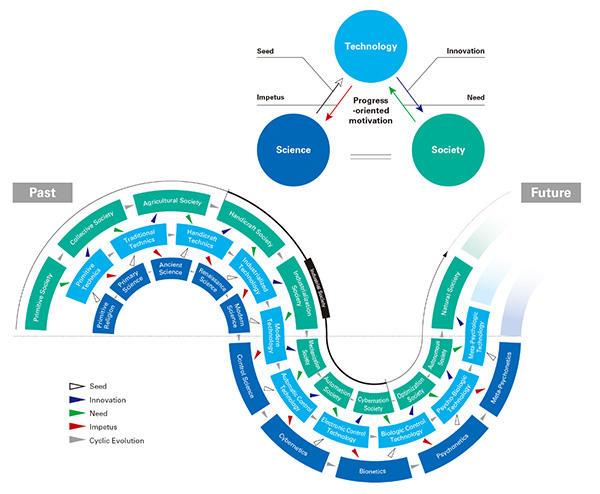
How will our lives be changed by popularization of remote healthcare, online education, autonomous vehicles, and unmanned delivery drones? Society can be reshaped dramatically by new technologies that did not previously exist, and it is no exaggeration to say that science and technology are behind the changes that are now making our daily lives safer and more convenient. OMRON has been working toward a better future by generating new technologies through its business activities, as well as supporting innovative research and backing the creation of new science. In this article, we profile some of the ways that OMRON is sowing the seeds of science and technology toward such a future.
ŃĆĆ
Have you ever thought about what kinds of technologies will exist in our lives in the near future, five or ten years from now? For example, the rise of mobile telephone technology has not only changed the way we communicate by telephone, but also transformed our everyday lives. Just as progress in ICT has enabled new ways of working and learning such as remote workplaces and online classes, scientific and technological advancements have the potential to cause major shifts in individual lifestyles and wider society. Distance education, remote healthcare, autonomous vehicles, unmanned delivery drones, and other new technologies currently spreading across society may also completely change the shape of our lives and communities in the near future. Science and technology underpins the realization of a safe and convenient society.
To achieve such a better society in the future, it is essential to comprehend the precursors of change in society, grasp the latent and yet-to-be-manifested needs of society at an early stage, and develop ways of satisfying those needs. To enable this process, OMRON's founder Kazuma Tateishi and his team formulated the SINIC Theory of future prediction. This theory, put forward by Tateishi in 1970, provides a basis for changing the world for the better by solving social issues through the use of a back-casting approach, one that takes near-future design as its starting point and considers what should be done in the present. The theory serves as a compass for the management of OMRON even today.
The basic idea behind the SINIC Theory is that science, technology, and society interact with one another as they develop. This interaction can go in two directions: from seeds (that originate in new scientific accomplishments and are passed on when new technologies are created) to innovation, where the impact of innovation drives the transformation of society. The other one is the opposite direction, where new needs in society encourage the development of new technologies to meet those needs, and if the needs cannot be addressed by existing science and technology, they serve as an impetus for new science to be born.
 The SINIC Theory
The SINIC TheoryMore details on the SINIC Theory can be found here.
Out of the two directions envisioned in the SINIC Theory, OMRON places primary emphasis on the development of new technologies out of societal needs. Meanwhile, the generation of "new science" is enabled through research grants provided by the Tateishi Science and Technology Foundation. The Foundation's work supports the process of sprouting and nurturing the seeds of "new science" even before anybody has perceived the new needs they will address, leading to the creation of new innovations that will transform society in the future.
The Foundation was established in 1990 when the founder Kazuma Tateishi and former Chairman Takao Tateishi contributed shares they personally held in OMRON Corporation and the company itself also provided a donation. The Foundation offers grants to research and international exchange projects that promote "harmony between humans and machines," thereby contributing to the advancement of science and technology in society and the creation of "new science," thereby helping to solve social problems.
The Foundation's focus on research that promotes "The harmony between humans and machines" is based on the founder Kazuma Tateishi's management philosophy: "To the machine, the work of the machine, to man the thrill of further creation." The Foundation's significance lies in its advancement of this philosophy through grants for ambitious, future-oriented research consistent with this philosophy, being selected from across society.
ŃĆĆ
The Foundation's grant recipients for the 2021 fiscal year were announced on April 23 this year. Following a rigorous evaluation by the selection committee and final determination by the board of directors, 47 projects were selected for research grants, and one was selected for an international exchange grant for the first half of the fiscal year. Since the first grants were awarded in fiscal 1990, the Foundation has issued a cumulative total of 888 research grants valued at 2,462.57 million yen overall, and 526 international exchange grants valued at 255.84 million yen.
Each of the research projects selected addresses a theme that advances the "harmony between humans and machines," a focus that has remained unaltered throughout the Foundation's three decades of operation. It is the Foundation's hope that the projects it funds will sprout the seeds of new science and lead eventually to the development of new technologies that transform society. Both the Tateishi Science and Technology Foundation and OMRON Corporation will continue their unrelenting efforts to uphold Kazuma Tateishi's commitment to contributing to the advancement of near-future science and technology and the creation of new innovations.